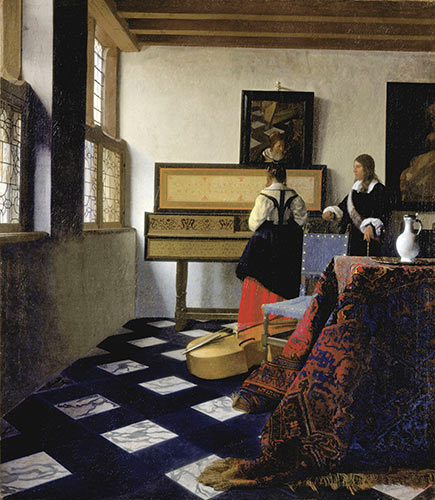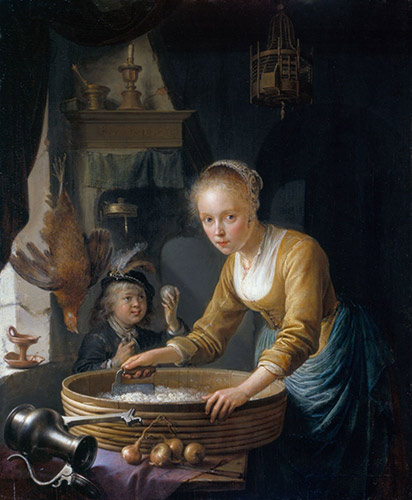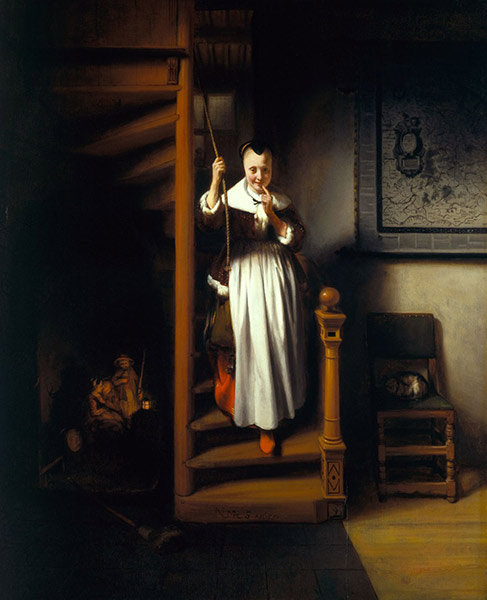The Royal Collection is regarded as one of the finest gatherings of art in the world. Although known for its range and diversity, the collection is particularly strong in painting from the Dutch Golden Age (spanning roughly the 17th century), 27 of which are on view now at the Queen’s Gallery.
Skilled in capturing the subtle effects of light in paint and nearly perfect naturalists, painters of the Dutch Golden Age were masters of everyday –- perhaps ordinary –- subjects. In a striking break from the traditional, highly religious content of artworks in southern Europe, Dutch painters, and their patrons, preferred to celebrate their simple, prosperous way of life through exquisite still life, landscape, portraiture, and genre works.

Johannes Vermeer, “The Music Lesson,” ca. 1662-1665, oil on canvas, 74 x 64.6 cm. (c) The Royal Collection Trust,
Her Majesty Queen Elizabeth II, 2015
Boasting one of the most extensive collections of Dutch Golden Age painting, the curators of The Royal Collection often loan these precious works to museums all over the globe, as almost every culture has found much to appreciate through the ordinary subjects and exquisite detailing. Be that as it may, 27 masterpieces from the collection have been carefully selected for “Masters of the Everyday: Dutch Artists in the Age of Vermeer,” which debuted at The Queen’s Gallery at Buckingham Palace earlier this month.
As expected, the exhibition features the biggest names from the period, including Gerrit Dou, Gabriel Metsu, Jan Steen, Pieter de Hooch, and, of course, Johannes Vermeer. From the exhibition website: “While the subject-matter may be ordinary –- the preparation of food, eating and drinking, the enjoyment of music or a family game -– the painting is rich and jewel-like, with equal attention paid to a discarded pipe as to a fine silk drape. The meticulously documented details often allude to a work’s deeper meaning, or to moral messages that would have been familiar to the contemporary viewer.”

Gerrit Dou, “A Girl Chopping Onions,” 1646, oil on panel, 21 x 16.8 cm. (c) The Royal Collection Trust,
Her Majesty Queen Elizabeth II, 2015
Paintings by Vermeer are, without a doubt, highlights of any exhibition in which they’re included, and it is no different here. Although it would be hard to distinguish a hierarchy of Vermeer’s surviving 34 works, “The Music Lesson” of 1662-1665 is arguably one of his best. Characteristic of the painter’s work, we find two subjects –- a male teacher and female student –- within a well-lit interior. No detail has been omitted, from the individual strands and knots of the rug in the foreground, to the marbling in the quintessential checkered floor, to the intricate inlay on the girl’s virginal. So accurate and detailed is the painting that it could be read as more photographic than painterly. Regardless, the work stands as one of the finest examples to have survived from the Golden Age.

Attrib. Ferdinand Bol, “Rembrandt and Saskia,” ca. 1638, oil on canvas, 154 x 200 cm. (c) The Royal Collection Trust,
Her Majesty Queen Elizabeth II, 2015
“Masters of the Everyday: Dutch Artists in the Age of Vermeer” opened on November 13 and will hang until February 14. In September 2016, the exhibition will travel to the Mauritshuis, the Hague.
To learn more, visit The Royal Collection Trust.
This article was featured in Fine Art Today, a weekly e-newsletter from Fine Art Connoisseur magazine. To start receiving Fine Art Today for free, click here.







